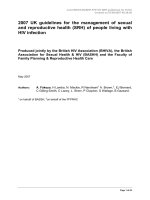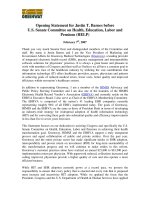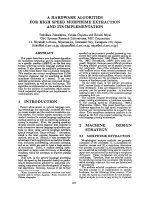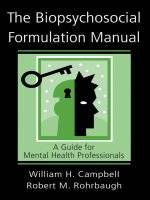The Inflammation Syndrome: Your Nutrition Plan for Great Health, Weight Loss, and Pain-Free Living ppt
Bạn đang xem bản rút gọn của tài liệu. Xem và tải ngay bản đầy đủ của tài liệu tại đây (1.55 MB, 304 trang )
The
Inf lammation
Syndrome
Completely Revised and Updated
Your Nutrition Plan
for Great Health, Weight Loss,
and Pain-Free Living
Jack Challem
AU T H O R O F T H E B E S T S E L L I N G S Y N D RO M E X
Foreword by Ronald Hunninghake, M.D., & Hugh Riordan, M.D.
The
Inflammation
Syndrome
Your Nutrition Plan for Great Health,
Weight Loss, and Pain-Free Living
Completely Revised and Updated
Jack Challem
John Wiley & Sons, Inc.
Copyright © 2010 by Jack Challem. All rights reserved
Published by John Wiley & Sons, Inc., Hoboken, New Jersey
Published simultaneously in Canada
The Inflammation Syndrome™ and Anti-Inflammation Syndrome™ are trademarks of
Jack Challem.
Table on page 56 is from S. B. Eaton and S. B. Eaton II, “Paleolithic vs. Modern Diets—
Selected Pathophysical Implications,” European Journal of Nutrition 39, no. 2 (2000):
67–70. Reprinted with kind permission of Springer Springer & Business Media.
No part of this publication may be reproduced, stored in a retrieval system, or transmitted in any form or by any means, electronic, mechanical, photocopying, recording,
scanning, or otherwise, except as permitted under Section 107 or 108 of the 1976
United States Copyright Act, without either the prior written permission of the Publisher, or authorization through payment of the appropriate per-copy fee to the Copyright Clearance Center, 222 Rosewood Drive, Danvers, MA 01923, (978) 750-8400,
fax (978) 750-4470, or on the web at www.copyright.com. Requests to the Publisher
for permission should be addressed to the Permissions Department, John Wiley &
Sons, Inc., 111 River Street, Hoboken, NJ 07030, (201) 748-6011, fax (201) 748-6008,
or online at />The information contained in this book is not intended to serve as a replacement for
professional medical advice. Any use of the information in this book is at the reader’s
discretion. The author and the publisher specifically disclaim any and all liability arising
directly or indirectly from the use or application of any information contained in this
book. A health care professional should be consulted regarding your specific situation.
Designations used by companies to distinguish their products are often claimed as
trademarks. In all instances where John Wiley & Sons, Inc., is aware of a claim, the
product names appear in Initial Capital or ALL CAPITAL letters. Readers, however,
should contact the appropriate companies for more complete information regarding
trademarks and registration.
For general information about our other products and services, please contact our Customer Care Department within the United States at (800) 762-2974, outside the United
States at (317) 572-3993 or fax (317) 572-4002.
Wiley also publishes its books in a variety of electronic formats. Some content that
appears in print may not be available in electronic books. For additional information
about Wiley products, visit our website at www.wiley.com.
Library of Congress Cataloging-in-Publication Data:
Challem, Jack.
The inflammation syndrome : the complete nutritional program to prevent and
reverse heart disease, arthritis, diabetes, allergies, and asthma / Jack Challem.—Rev.
and expanded ed.
p. cm.
Includes bibliographical references and index.
ISBN 978-0-470-44085-8 (pbk.)
1. Inflammation—Diet therapy. 2. Inflammation—Alternative treatment. 3. Chronic
diseases—Etiology. I. Title.
RB131.C475 2010
616'.0473—dc22
2009037586
Printed in the United States of America
10 9 8 7 6 5 4 3 2 1
In memory of Harold G. Miller,
teacher, mentor, and friend
CONTENTS
Foreword by Ronald E. Hunninghake, M.D.,
and Hugh D. Riordan, M.D. vii
Acknowledgments xi
Introduction to the Original Edition 1
Introduction to the Revised Edition 6
Part I The Inflammation-Disease Connection
1
Meet the Inflammation Syndrome 13
2
Your Inflammation Triggers 25
3
The Dietary Causes of Inflammation 33
4
Correcting a Diet That’s Out of Balance 47
5
11
What’s Wrong with Anti-Inflammatory Drugs 62
Part II The AI Diet Plan
71
6
Fourteen Steps to Fight the Inflammation Syndrome 73
7
The AI Diet Menu Plans and Recipes 93
Part III The AI Supplement Plan
123
8
Good Fats That Rev Up Your Body’s Natural
Anti-Inflammatories 125
9
The Power of Anti-Inflammatory Herbs 142
10
The Anti-Inflammatory Benefits of a Multivitamin
Supplement 155
v
vi
11
contents
Glucosamine, Chondroitin, and Other Supplements for
Osteoarthritis 166
Part IV Putting Anti-Inflammation Syndrome
Nutrients to Work for You 175
12
The Inflammation Syndrome, Diseases, and Specific
Conditions 177
Afterword: Stay Healthy for Life 250
Index 253
FOREWORD
Occasional injuries are part of the human experience, and healing is the
body’s self-repair process. Healing begins with inflammation, which
nature uses to clean up damaged tissues and protect against infection.
So if inflammation is beneficial, why are so many modern diseases
characterized by chronic and unhealthy inflammation?
This revised edition of The Inflammation Syndrome answers a major
part of this important question. Chronic inflammation underscores
and promotes virtually every disease, affecting millions of people, yet
inflammation is also a symptom rather than the fundamental cause of
these diseases. When we dig deeper, we find that chronic inflammation
is the consequence of an injury to the body, combined with nutritional
imbalances or deficiencies. To properly treat inflammatory diseases, it
is essential to correct the underlying dietary problems.
We speak from experience. At the Center for the Improvement of
Human Functioning International, physicians, nurses, and other staff
members have focused on these objectives for more than thirty years.
We use careful clinical and laboratory workups—what is now termed
evidence-based medicine—to assess the health, nutritional reserves,
and biochemical uniqueness of each patient. We have successfully
treated people from around the country and around the world, many
of whom were considered untreatable or incurable by conventional
medicine.
Through these detailed individual workups, we have gained an
understanding of chronic, or sustained, inflammation. More often than
not, individuals with chronic inflammation, such as arthritis and asthma,
have low levels of anti-inflammatory antioxidants (for example, vitamins
E and C), omega-3 fatty acids, and other important nutrients. Many
patients also have previously undetected adverse food reactions, abnormal gut permeability, yeast overgrowth, and hormonal imbalances. All
vii
viii
foreword
of these factors can impair the normal functioning of the immune system,
sustaining inflammation well beyond its biological usefulness.
The pharmaceutical perspective of inflammation focuses on relieving symptoms through over-the-counter analgesics and far more powerful prescription drugs. Inflammation does not result from a deficiency
of aspirin, cortisone, or Cox-2 inhibitors. Rather, as The Inflammation
Syndrome so well documents, there is a desperate need to address the
basic nutritional influences on chronic inflammation. After all, no drug
can ever make up for a nutritional deficiency. Under these circumstances, it becomes paramount to nourish a person’s biochemistry with
the best nutrition.
This is where measuring a patient’s nutrient levels proves to be so
helpful in confirming the underlying nutritional and biochemical causes
of inflammation and in motivating patients to act. It would be easy to
lecture a patient on the anti-inflammatory effects of good nutrition,
omega-3 fatty acids (which include fish oils), or vitamin E. But a far
more powerful motivator is testing and demonstrating the patient’s low
levels of specific nutrients.
By doing so, we have found time and again that such hard evidence
is extremely persuasive. This meaningful individual information, combined with the ease of making dietary improvements and taking supplements, empowers patients with knowledge and motivates them to
undertake self-healing. Patients develop the attitude “I want my levels
to be optimal,” and then they work toward achieving them. Furthermore,
from our medical perspective, laboratory testing enables us to later
recheck nutrient values to confirm proper absorption and utilization.
Through testing, we have realized that no one can ever assume that
a person’s diet is adequate. For example, a cardiac surgeon would never
simply hope his patient’s potassium level is sufficient to prevent fatal
arrhythmias during heart surgery; he ensures that it is. The same approach
applies to the treatment of chronic inflammation. To achieve optimal
levels of many nutrients, one must often consume amounts of vitamins,
minerals, and other nutrients greater than those “officially” recommended for health. There is nothing wrong in doing so, especially when
tests have shown patients to be low in these nutrients. At the very least,
erring on the side of modest excess provides a margin of safety, a dose
of nutritional insurance.
Jack Challem, the author of The Inflammation Syndrome, is a gifted
health writer with a profound understanding of the role good nutrition
plays in health. He has written a sound and practical book of benefit to
foreword
ix
anyone with chronic inflammation. As we read and discussed his book,
we visualized Jack working in a huge lighthouse. The light being emitted is the cumulative scientific evidence so deftly organized and clearly
presented here. The danger is the jagged rocks of chronic, sustained
inflammation, which underlie almost every serious health issue facing
modern society—and the reason for the lighthouse. All of us—readers,
patients, and physicians alike—are piloting our own boats and, as a society, we are heading for the rocks. Will we see the light? Can we avoid the
forces making us drift in the dark? To survive, we must rediscover the
great Hippocratic ideal: Let food be thy medicine.
—Ronald E. Hunninghake, M.D.
Medical Director
The Olive W. Garvey Center for Healing Arts
Wichita, Kansas
—Hugh D. Riordan, M.D.
Founder
The Center for the Improvement of
Human Functioning International, Inc.
Wichita, Kansas
ACKNOWLEDGMENTS
Many individuals made major and minor contributions to my thinking on inflammation and to this updated edition of The Inflammation
Syndrome.
My good friend Ron Hunninghake, M.D., has often brainstormed
with me on the role of diet in inflammation and many other health topics. In the course of our numerous discussions, we’ve helped shape each
other’s views of inflammatory diseases, and I am appreciative of his
time and friendship. The work of many other people, such as Björn
Falck Madsen, Søren Mavrogenis, Melissa Diane Smith, Ashton and
Matt Embry, the late Abram Hoffer, M.D., Ph.D., and others, has also
contributed to my views on eating habits and supplements.
I want to thank my previous literary agent, the late Michael Cohn,
and my current agent, Jack Scovil, for their support in getting my ideas
published. I also thank my editor, Tom Miller, who has always encouraged me to clarify and simplify the complexities of health and self-help.
I would also like to thank Kimberly Monroe-Hill and Patricia Waldygo
for their careful editing of this book.
Finally, I thank my nutrition coaching clients and my many fans and
readers, whose positive feedback always brightens my days.
Introduction
to the Original Edition
One condition explains your stiff fingers, aching muscles, and arthritic
joints. One condition lies at the root of your troublesome allergies and
asthma. And one condition describes the underlying cause of heart disease, Alzheimer’s disease, and some types of cancer.
It is inflammation.
As you read this, medicine is rapidly redefining coronary artery
(heart) disease, the leading cause of death among people in the United
States and most other Westernized nations, as an inflammatory disease of
the blood vessels. Physicians are quickly adopting a new and inexpensive
blood test—high-sensitivity C-reactive protein—to measure their
patients’ level of inflammation and risk of suffering a heart attack. And as
the evidence mounts, physicians and medical researchers are recognizing
that other major chronic diseases are fueled by inflammation as well.
Most of us understand inflammation as something that causes redness, tenderness, stiffness, and pain. It is the core of inflammatory “-itis”
disease, and it also is intertwined in every disease, including obesity, diabetes, and multiple sclerosis.
Inflammation is why professional athletes and weekend warriors
often development muscle aches. It is why some people’s gums bleed
whenever they brush their teeth. And it is why some people develop stomach ulcers.
1
2
the inflammation syndrome
Despite their different symptoms, all of these health problems are
united by the same thread: they have runaway inflammation in common.
And as you may well realize, many people suffer from more than one
inflammatory disorder. This constellation of related diseases, such as the
combination of heart disease, arthritis, and periodontitis, can best be
described as the Inflammation Syndrome.
k
Estimated Number of North Americans with
Some Inflammatory Diseases
Millions of North Americans suffer from inflammatory disorders, some
of which have only recently been recognized as inflammatory in nature:
Allergic and nonallergic rhinitis
Asthma
Cardiovascular diseases
Arthritis (all types combined)
Osteoarthritis
Rheumatoid arthritis
39 million
17 million
60 million
70 million
21 million
2 million
k
Everyone experiences inflammation at one time or another, and we actually need it to survive. But chronic inflammation is a sign that something
has gone seriously awry with your health. Instead of protecting and healing, chronic inflammation breaks down your body and makes you older
and more frail.
Most people treat inflammation with one or more over-the-counter or
prescription drugs. At best these drugs temporarily mask the symptoms of
inflammation, not treat its underlying causes. Worse, the side effects of
these drugs can often be extraordinarily dangerous, causing weight gain,
severe stomach pain, bone deformities, and heart failure.
Unfortunately, a physician’s diagnosis of many -itis diseases, such as
dermatitis or gastritis, is often meaningless. The doctor might feel proud
of his diagnosis, but it is merely a description of the symptoms, not of
its cause.
To understand the cause of the modern epidemic of inflammatory diseases, we have to look at how the average person’s diet has deteriorated
over the past two or three generations. The bottom line is that the foods
introduction to the original edition
3
you eat have a powerful bearing on your health and, specifically, inflammation.
How does food influence your inflammation, your aches and pains?
Your body is a remarkable biological machine, designed to make an
assortment of pro- and anti-inflammatory substances. What you eat—proteins, carbohydrates, fats, vitamins and vitaminlike nutrients, and minerals—provides the nutritional building blocks of these substances. Some
nutrients help form your body’s inflammation-promoting compounds,
which normally help fight infections. Others help produce your body’s
anti-inflammatory substances, which moderate and turn off inflammation.
Until recently, people ate a relative balance of pro- and antiinflammatory nutrients. Today, because of extensive food processing,
our diet has become seriously unbalanced. The typical Western diet now
contains at least thirty times more of pro-inflammatory nutrients than
just a century ago. As a result, people have become nutritionally and biochemically primed for powerful, out-of-control inflammatory reactions.
An injury, infection, or sometimes nothing more than age-related wear
and tear create the spark that, in a manner of speaking, sets your body
on fire.
The Inflammation Syndrome reveals many of the hidden dangers in
foods that set the stage for inflammation, worsen aches and pains, and
increase the long-term risk of debilitating and life-threatening diseases.
This book explains how and why inflammation eats away at your health.
For example:
• Common cooking oils, such as corn, safflower, and soy oils, can
make arthritis and asthma worse.
• Fries and other deep-fried foods, breakfast bars, and cookies can
interfere with your body’s innate ability to control inflammation.
• Corn-fed beef, promoted as healthy, is far worse than grass-fed beef
and can aggravate your inflammation.
• Not eating your vegetables or taking your vitamins can increase
breathing problems in people with asthma.
• Being overweight increases your body’s production of inflammationcausing substances.
• Taking common anti-inflammatory drugs will actually make your
osteoarthritis far worse.
• If you have one inflammatory disease, you are likely to develop others in the coming years, because the inflammation will eventually
spread and affect other parts of your body.
4
the inflammation syndrome
I have had my own experience with inflammation and how I have
avoided chronic pain. Several years ago, while in the British Museum in
London, I paid careful attention to a sign reading “Mind the Step.” Unfortunately for me, the area was not well lit and the sign failed to warn me of
a second step. I tripped and seriously injured my right foot. The pain was
so excruciating that I almost passed out. I sat down while my head cleared
and, I had hoped, for the pain to ease.
It didn’t. By the next morning, my entire foot was literally turning
black and blue. Although no bones were broken, I did give myself one of
the most serious types of muscle strain. A couple of days later, on the
next leg of my trip, in France, I hobbled around at a scientific conference on antioxidant vitamins. Climbing into the shower was an ordeal,
as was putting on my socks and shoes. My foot had swelled, its color
was awful, and I was taking aspirin several times daily to reduce the
inflammation, swelling, and pain.
Weeks later, at home, my foot had regained its normal color and, by all
outward signs, had healed. However, I still felt a sharp pain in the foot
whenever I walked. I realized that this injury, if it did not heal soon and
properly, could lead to a lifetime of chronic inflammation and pain. Frustratingly, all of the vitamin supplements I had been taking for years didn’t
seem to help. And then it dawned on me. That scientific meeting in France
was about a well-known herbal antioxidant made from French maritime
pine bark (called Pycnogenol), and the scientific literature showed it to
have powerful anti-inflammatory effects. I started taking it, and within days
the pain went away. To rule out the power of suggestion, I stopped taking
the supplement for a few days, and the pain returned. I started taking the
supplement again and the inflammation and pain went away and have never
returned. I walk and hike long distances without any discomfort in the foot.
The Inflammation Syndrome does not simply dwell on the problem of
inflammation. Most of this book coaches you on how to avoid the foods
that make you more susceptible to inflammation and to instead select
foods that can reduce inflammation and your risk of many diseases. The
Inflammation Syndrome describes a new way of viewing inflammatory
disorders as a consequence of eating an unbalanced diet.
You will learn plenty of practical information about how to prevent
and reverse inflammation. The book’s Anti-Inflammation [AI] Syndrome
Diet Plan describes
• the dietary imbalances that lead to chronic inflammation;
• a balanced, nutritious diet plan to reduce inflammation;
introduction to the original edition
5
• tasty recipes and guidelines for making your own anti-inflammatory meals;
• the best natural anti-inflammation supplements, such as fish oils,
vitamin E, herbs, and many others;
• case histories of patients treated by nutritionally oriented practitioners.
You may wonder why you should trust the advice of someone who is
not a physician.
The reason is simple, though it may surprise you: while I believe the
majority of physicians are sincere and well-meaning, most do not understand the fundamental role of nutrition in health. Medical schools teach
virtually nothing about the practical, preventive, and therapeutic uses of
nutrition and supplements. The doctors I write about in this book are
notable exceptions to this rule in that they are both sincere and have an
understanding of nutrition.
For more than twenty-five years, I have been reading scientific and
medical journals; talking with nutritionally oriented biologists, biochemists, and physicians; and writing about how vitamins, minerals, and
other aspects of nutrition can greatly improve health. I have also published original research articles in medical journals, something rare for
nutrition writers. Though I am not a medical scientist, I have a solid
understanding of the science behind the health benefits of nutrition and
supplements.
In many ways, The Inflammation Syndrome expands on the concepts
described in my previous book Syndrome X: The Complete Nutritional
Program to Prevent and Reverse Insulin Resistance. Far more than genes,
poor eating habits are at the core of most modern degenerative disorders,
including chronic inflammation. The Inflammation Syndrome is supported by hundreds of scientific studies and by successful clinical experiences, many of which you will read. Some of my scientific references are
at the back of this book, and I encourage you to share all of them with your
physician. [As of the revised edition, the references have been moved to
www.inflammationsyndrome.com.]
Ultimately, you alone are responsible for your own health. You cannot
ignore your personal responsibility and simply turn your body over to a
doctor the way you might ask a mechanic to fix your car. This book provides a plan for you to empower yourself to safely prevent and overcome
inflammatory disorders. You will discover how easy it is to take charge of
your diet and your health—and to feel better than you ever imagined.
Introduction
to the Revised Edition
When The Inflammation Syndrome was first published early in 2003,
it proposed what was then a bold and audacious idea—that many different types of inflammatory diseases were related to one another. Today,
this idea is widely accepted.
Indeed, a great deal has changed over the last few years, necessitating this updated edition of the book. First, inflammation is now recognized as an undercurrent in all disease processes. Second, inflammation
(not cholesterol) is now understood to be the primary determining factor
in coronary heart disease, which is the leading cause of death in most
developed countries, although many doctors are yet to act on this knowledge. Third, inflammatory disorders—for example, allergies, arthritis,
heart disease, and inflammatory bowel disease, to name but a few—share
common causes and also increase the risk of developing other inflammatory diseases.
What events have led to such dramatic changes in the perception of
inflammation?
Medical thinking about the role of inflammation in disease began to
broaden in the late 1990s, following the development and increased use
of the high-sensitivity C-reactive protein (hsCRP) test. The test was revolutionary in that it could measure subtle, low-grade inflammation—the
type of inflammation that is not always obvious but that slowly breaks
6
introduction to the revised edition
7
down the body and leads to chronic degenerative diseases. Researchers
at Harvard Medical School showed that chronic low-grade inflammation
was a major factor in the development of heart disease and, just as important, that the CRP test could identify people who were at risk of suffering
a heart attack. In fact, high levels of CRP are a far better predictor of heart
attack risk than is cholesterol.
It didn’t take long before other researchers began to look for elevated
CRP levels in other diseases. What they found was fascinating and
further shifted medical thinking about the role of inflammation in disease. For example, people who are overweight or have type 2 diabetes
typically have elevated CRP levels. Being overweight and having type 2
diabetes are major risk factors for heart disease, another proof of the disease linkage that forms the inflammation syndrome. Almost everyone
with type 2 diabetes is overweight, and fat cells (particularly those that
form around the waistline) secrete inflammation-producing compounds,
including interleukin-6 (IL-6) and CRP.
k
The Prevalence of Some Inflammatory Diseases
in North America
How has the prevalence of inflammatory diseases changed since the first
edition of The Inflammation Syndrome was published in 2003? Compare
the numbers below with those on page 2.
Allergic and nonallergic rhinitis
Asthma
Cardiovascular diseases
Arthritis (all types)
Osteoarthritis
Rheumatoid arthritis
Diabetes/prediabetes
Overweight/obesity
Cancers
Rhinitis
Gingivitis
Sinusitis
Inflammation syndrome
k
39 million
22 million
60 million
70 million
21 million
2 million
100 million
120 million
3.4 million (30% of all cancers)
56 million
270 million
40 million
250 million (estimated)
8
the inflammation syndrome
At the same time, there has been a surge in research on natural antiinflammatory substances, such as certain foods, herbs and spices, and
supplements, and my discussion of these substances forms the core of
The Inflammation Syndrome. Here’s the good news: you can use these
natural substances to safely reduce inflammation and pain and restore
your health.
What’s new in this edition of The Inflammation Syndrome?
• I have updated much of the information throughout the book,
based on recent scientific and medical research. (To save space,
my references appear at www.inflammationsyndrome.com.)
• I have simplified many of my recommendations to make them
more practical and easier to follow. For example, companies market dozens of anti-inflammatory supplements, but I have focused
on the ones most strongly supported by scientific research. I also
recommend specific brands of products (which I tended to avoid
doing in the past), to make purchasing decisions easier for you.
• I discuss several natural anti-inflammatory substances produced
by the body that have been discovered since I wrote the first edition of this book. These remarkable compounds include resolvins,
protectins, and lipoxins, and the body makes them from healthy
dietary fats. Their activity can be increased through both diet and
supplements.
• I explain the research that demonstrates the benefits of curcumin,
one of the most powerful natural anti-inflammatory compounds.
Curcumin is an extract of the spice turmeric, and the latest
research indicates that it blocks ninety-seven different inflammatory mechanisms in the body—more than any other natural or
synthetic substance.
• I also discuss at length the anti-inflammatory properties of another
natural compound, Pycnogenol. Long known for its cardiovascular effects, this extract of French maritime pine bark has impressive and scientifically documented anti-inflammatory benefits.
• In the first edition of The Inflammation Syndrome, I explained how
gamma-linolenic acid (a plant oil) has a potent anti-inflammatory
action and is synergistic with the inflammation-quenching omega3 fish oils. Over the last few years, researchers have documented
still more health benefits from gamma-linolenic acid, and I have
included a discussion of these.
introduction to the revised edition
9
• Similarly, the research on the health benefits of omega-3 fish oils
has amounted to a medical landslide. Almost every week, medical and scientific journals report new advantages of consuming
fish oils. I have included more recent and comprehensive information on omega-3 fish oils.
• I also include information on vitamin D, which has emerged as an
immune-modulating and anti-inflammatory nutrient, and on
many other nutrients you may lack in your diet.
• There’s much more in the updated edition of The Inflammation
Syndrome, such as new recipes for tasty anti-inflammatory meals.
Before you read further, I would like to share three brief case histories about how The Inflammation Syndrome has helped people regain
their health and their lives.
Susan had long suffered with frightening episodes of asthma. Like
many other people, she had gone from doctor to doctor, and then a specialist (a pulmonologist) prescribed several different medications to control her asthmatic symptoms. She still had to use a steroid-containing
inhaler several times a day. After she followed the advice in The Inflammation Syndrome for only one month, her symptoms decreased, and
now she often goes an entire week without having to use the inhaler.
Susan has also been able to reduce her other medications.
Deirdre had dealt with the crippling symptoms of Epstein-Barr
infection and inflammatory pain for years. After reading The Inflammation Syndrome, she added gamma-linolenic acid supplements to her
regimen—without making any changes to her diet—and nearly all of
her muscle and joint pain disappeared. Her initial success motivated
Deirdre to take other supplements, including vitamins C and E, and then
to make important dietary changes. She has had such a dramatic recovery that she now recommends a similar program to her relatives.
When Jennifer read The Inflammation Syndrome, everything about
her health and that of her family suddenly made sense. She weighed
more than three hundred pounds and had type 2 diabetes. She and other
family members had allergies, a brother and a sister had inflammatory
bowel disease, and her mother had ulcers. Jennifer felt better within several days of beginning to follow my dietary recommendations and
e-mailed me: “This book has changed my life!” Jennifer has a lot of
health issues to deal with, but she’s on the right track and was quickly
able to start walking without her cane.
10
the inflammation syndrome
These are some of the many success stories I’ve heard from readers.
These people have been successful in large part because, for the first
time in their lives, they’ve been able to “connect the dots” in their
inflammatory disorders—and then take small and big steps toward
regaining their health. You can, too!
PART I
The InflammationDisease Connection









